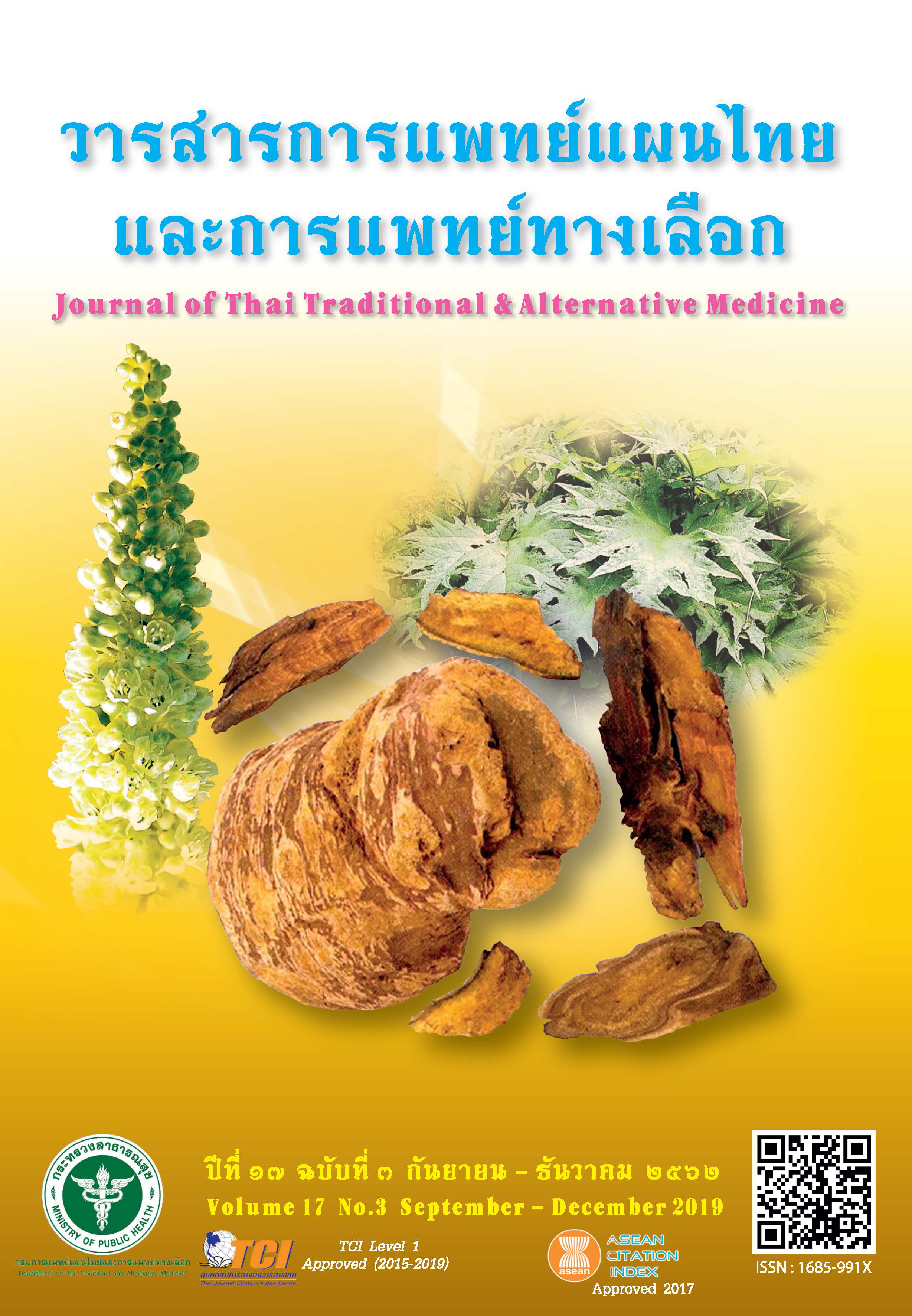Quality Control of Ya Thatu Obchey Preparation by High Performance Liquid Chromatography
Main Article Content
Abstract
Ya thatu obchey preparation is a herbal remedy in the Thai National List of Essential Medicines which is used for the treatment of indigestion. The quality control methods of the mixture have not been reported. The Objective of this study was to identify constituents in Ya thatu obchey preparation and to quantify contents of chemical markers in the preparation by High Performance Liquid Chromatography (HPLC). Qualitative and quantitative analyses of the samples were determined using HPLC method. The method was validated on parameters including linearity, accuracy, and precision. From this study, gallic acid, cinnamic acid, glycyrrhizin, cinnamaldehyde and
eugenol, were simultaneously detected in HPLC chromatogram and identified by comparison with those of the standard compounds. Chemical markers (cinnamic acid, glycyrrhizin, eugenol) presented good linearity within the test range (r2 > 0.9950). The limit of detection and the limit of quantitation varied from 0.08 to 0.24 μg/ml and 0.30 to 2.24 μg/ml, respectively. The relative standard deviations of intraday precision were 0.86 to 3.51%. The relative standard deviations of intraday precision of compounds were 0.94 to 6.03%. The recovery of the method was in the range 85.27 to 102.80%. The contents of marker compounds in Ya thatu obchey preparation samples were also quantified by this HPLC method. The results showed that the contents of cinnamic acid, glycyrrhizin, and eugenol were 0.04 to 0.11, 0.70 to 3.15 and 0.19 to 3.38%w/w, respectively. In conclusion, the HPLC method is suitable for qualitative and quantitative analysis of chemical markers in Ya thatu obchey preparation. However, Ya thatu obchey preparation consists of various monoterpenes. This group of compounds generally lacks UV-Visible absorption chromophores. Therefore, other analytical techniques should be selected to determine these constituents.
Article Details
References
2. Boonyaprapat, N. Chokchaicharoenporn O. Medicinal plants indigenous to Thailand 1. Bangkok: Prachachon Co. Ltd; 1996. 895 p. (in Thai)
3. Ayurvada college (Komarapat). Textbook of Thai traditional pharmacy. Bangkok: Usa printing; 2016. 264 p. (in Thai)
4. Jindarat S, Muangnoi C, Changsiriporn D, Platong A, Thanamontra B, Chiewchanwit D, Vongvanvatana V, Rongrungsri N, Krittasilp K, Kaewkong N, Kantawan S, Virasombat N, Mongkolporn V, Prakobkij W, Wanleepong K, Maneekul C, Benchakhanta S, Boonpok P, Kunnasut W, Tongkleaw L, Vatthanasak A, Mookkhan J, Jatuporn C, Tuntiprawan K, Teerawongseree S, Ussawasrisuwan S, Thamcharoen P, Keawsontaya T, Chuthaputti A, Termviset P, Thamlikitkul V. Efficacy and safety of cinnamon stomachic mixture for patients with functional dyspepsia. Siriraj Medical Journal. 2006;58(11):1103-6.
5. Gursale A, Dighe V, Parekh G. Simultaneous quantitative determination of cinnamaldehyde and methyl eugenol from stem bark of Cinnamomum zeylanicum Blume using RP-HPLC. Journal of Chromatographic Science. 2010;48(1):59-62.
6. Cortés-Rojas DF, de Souza CRF, Oliveira WP. Clove (Syzygium aromaticum): a precious spice. Asian Pacific Journal of Tropical Biomedicine. 2014;4(2):90-6.
7. Wang Z, Kurosaki Y, Nakayama T, Kimura T. Mechanism of gastrointestinal absorption of glycyrrhizin in rats. Biological and Pharmaceutical Bulletin. 1994;17(10):1399-403.
8. Baruah A, Nath SC. Panicle and bark oils of a variant of Cinnamomum bejolghota (Buch-Ham) Sweet. from North East India. Journal of Spices and Aromatic Crops. 2002;11(2);135-7.
9. Sirat HM, Lim FH, Khaw SH. Chemical compositions of the essential oil of the fruits of Amomum testaceum Ridl. Journal of Essential Oil Research. 2001;13:86-7.
10. ICH. Guidance for industry Q2B Validation of analytical procedures: methodology. International Conference on Harmonization; Geneva. Switzerland: 1996.
11. Nanjundaiah SM, Annaiah HN, Dharmesh SM. Gastroprotective effect of ginger rhizome (Zingiber officinale) extract: role of gallic acid and cinnamic acid in H+,K+-ATPase/H. pylori inhibition and anti-oxidative mechanism. Evid Based Complement Alternat Med 2011;2011:249487. doi: 10.1093/ecam/nep060. PubMed PMCID: PMC3136331
12. Santin JR, Lemos M, Klein-Júnior LC, Machado ID, Costa P, de Oliveira AP, Tilia C, de Souza JP, de Sousa JPB, Bastos JK, de Andrade SF. Gastroprotective activity of essential oil of the Syzygium aromaticum and its major component eugenol in different animal models. Naunyn-Schmiedeberg’s Archives of Pharmacology. 2011;383(2):149-58.
13. Yang DZ, An YQ, Jiang XL, Tang DQ, Gao YY, Zhao HT, Wu XW. Development of a novel method combining HPLC fingerprint and multi-ingredients quantitative analysis for quality evaluation of traditional Chinese medicine preparation. Talanta. 2011;85(2):885-90.


